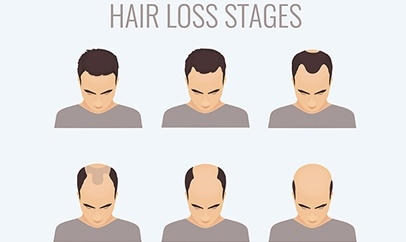
When performed by an experienced physician, a hair transplant surgery can produce lifelong results that are so natural that even hair stylists cannot detect them. Choosing the best hair restoration procedure and physician is critical to your hair restoration success.
Dr. Nader Ronaghi offers the most advanced and innovative hair loss treatments for both men and women by achieving the most realistic natural appearance.
It will be crucial that your specialist diagnose the evolution of your hair loss, as this will determine how aggressive treatment needs to be, what type of treatments will be used, and what results you can expect.
Hair Growth and Loss.
It is important to understand why hair loss happens. The portion of the hair that we can see is called the shaft. Each shaft of hair protrudes from its follicle, which is a tube-like pouch just below the surface of the skin. The hair is attached to the base of the follicle by the hair root, which is where the hair actually grows and where it is nourished by blood capillaries. Like the rest of the body, hairs are made of cells. As new cells form at its root, the hair is gradually pushed further and further out of the follicle. The cells at the base of each hair are close to the blood capillaries and are living.
As they get pushed further away from the base of the follicle, they no longer have any nourishment, and so they die. As they die, they are transformed into a hard protein called keratin. So, each hair we see above the skin is dead protein. It is the follicle, which lies deep in the skin, that is essential in growing hair. Also, the thickness of each hair depends on the size of the follicle from which it is growing.
Male-pattern baldness, also known as Androgenetic Alopecia, is a genetic condition that can be inherited from either side of the family. This type of baldness typically takes place after puberty, as this is when the levels of blood androgens increase.
Studies have shown that 96% of all hair loss in Caucasian Males begins as a receding hairline in the temporal area. This is true no matter what the final outcome of hair loss is. There are cases where those who lose their hair later in life (age 30 or over) develop different distributions and grades of baldness.
Many people think that hair loss only affects men. However, it is estimated that more than 50% of women will experience noticeable hair loss. The most significant cause of hair loss in women is female-pattern hair loss (FPHL), which affects about one-third of susceptible women, which equals out to some 30 million women in the United States.
Stages of Hair Loss.
The Ludwig scale defines three broad stages of hair loss. In stage 1, the hair on the top of the head begins thinning. In stage 2, the scalp starts to become visible. In stage 3, all of the hair at the crown may be lost, resulting in baldness.
1. Anagen Phase: this can last from two years to eight years.
The first phase is the growing stage. Hair grows at about 1 cm each month, and this phase can last between 2 and 5 years.
2. Catagen Phase: this is the time that hair follicles shrink and takes about two to three weeks.
As this phase begins, the bulb detaches from the blood supply, and the hair shaft is pushed up.
3. Telogen Phase: takes about two to four months.
This is followed by a resting stage, during which no growth occurs. This phase lasts about 5 months. At the end of the resting phase, the hair is shed, and the follicle starts to grow a new one. At any moment, about 90% of the hair follicles of the scalp are growing hairs in the first phase; only about 10% are in the resting phase. If a follicle is destroyed for any reason, no new hair will grow from it.
Causes:
If any of the stages of hair growth are disrupted, the individual may become bald.
In the most common causes of hair loss, i.e., androgenetic male and female pattern hair loss, genetic and/or hormonal influences lead to a shortening of the growing phase, which results in each affected hair being shed prematurely. Each new regrowing hair becomes shorter and finer than its predecessor. Progressively, this visibly results in thinning, or in more advanced cases, the hairs become so small (we call this miniaturization) that the scalp appears completely bald.
Dr. Nader Ronaghi offers FUE, which is where the hair is transplanted from the back or sides of the scalp to thinning areas, offering permanent hair growth. In order to achieve a natural look from your transplant depends on many factors, such as anterior hairline design, good density, the direction of implantation, use of appropriate follicular units in each location. At Pure Hair Restoration Center, all the above criteria are considered before placing a hair follicle.


